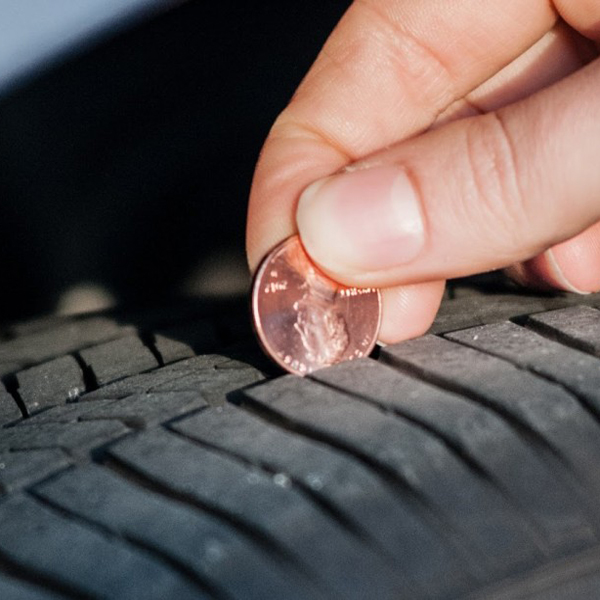One of the first maintenance tricks that many car owners learn is the penny test. However, many individuals do not know how to properly test their tires using a penny or what the results mean.
Tread depth is an important factor in tire function. If your tires do not have enough tread, they cannot properly grip the road. This deficiency can make your car handle poorly and create a safety hazard. In this blog, we discuss how and when the penny test should be used, as well as how you should respond to the results.
The Penny Test
The penny test is fairly simple, but many drivers do not feel confident in completing the test or interpreting the results. To test your treads, turn the penny upside down with Lincoln’s head facing you.
Insert the coin into your tire treads until the top of the coin touches the rubber at the bottom of the groove. On a tire with adequate tread, the top of Lincoln’s head will disappear. If you can see all of Lincoln’s head, the tread has worn down too low.
What many individuals do not know is that the penny test may not reflect all legal requirements for tread depth. In fact, by the time you can see all of Lincoln’s head, your treads have worn low enough that your tires are in violation of safety laws and in need of immediate replacement.
This fact makes the penny test an unreliable assessment that may encourage drivers to continue operating a car with dangerously worn out tires.
Instead, you may want to adopt the quarter test as outlined below.
The Quarter Test
On a penny, the space between the top of Lincoln’s head and the outside edge of the coin measures 2/32 of an inch, which is also the absolute minimum measurement of tire treads on most tire types.
On the quarter, however, the space between the top of Washington’s head and the edge of the coin measures 4/32 of an inch.
You complete the quarter test the same as the penny test. Simply hold the coin upside down with Washington’s face on the side of the coin you’re looking at. Insert the coin into the tire tread to measure. If Washington’s head is partially obscured by the tire, you have adequate tread for safe driving, even in wet conditions.
If Washington’s head is fully visible, it’s time to start shopping for new tires. Ideally, you should replace your tires while the treads fail the quarter test but still pass the penny test so you don’t spend any time driving on dangerously worn out treads.
Testing Accuracy
As with any other automotive test or maintenance you perform yourself, you want to ensure that your tread test results are accurate. Always follow these guidelines to properly test tire tread:
- Check that your tires are inflated properly before testing the tread. Tire pressure factors heavily into vehicle handling and can, in some cases, change the depth reading of tire treads. Improper tire pressure also contributes to uneven tire wear, shortening the overall lifespan of your tires.
- Complete the quarter or penny test at least once yearly, preferably before you start to experience cold and wet fall weather. If you live in a climate with precipitation throughout the year, check at least twice a year before the two rainiest seasons. Find new tires if you need them before the rain hits because inadequate tread contributes to the risk of hydroplaning.
- Insert the coin fully, without allowing it to roll to either side. If you can’t remember how to measure properly or want to check your results, measure using an official tire tread depth gauge instead of a coin.
- Test the portion of your tire that looks the most worn down first. If that section fails, the entire tire fails the test. Test multiple spots on the tire to ensure that you don’t miss a worn-out patch.
In addition to testing your tread once or twice annually, pay attention to the way your vehicle handles. You may want to visually inspect your tires when you hit a pothole, when you suspect you’ve driven over a sharp object, when you notice a tire pressure alert, or when you notice a change in how your car turns and stops.
If you notice drastically different results from different sections of your tires, you may have an alignment or rotation issue that needs to be diagnosed and addressed by a reputable mechanic.
Check your tread depth regularly so you can plan ahead and get new tires right when you need them. To learn more about maintaining your tires, including other ways to detect tread wear as it happens, read our blog “Tire Wear and Care.”
Is it time to start looking for new tires? Need a second opinion from an expert to determine whether or not your current tread is accurate? Find high-quality and cost-effective tires that provide your car with its best handling from Evans Tire and Service Centers.

